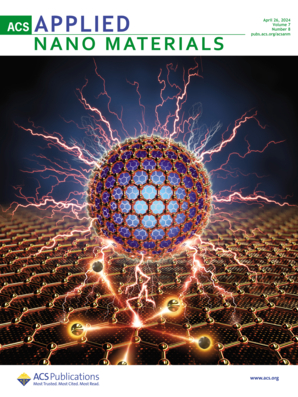Introducing dibenzocyclooctatetraene into actinide chemistry: isolation of rare trivalent uranium sandwich complexes
IF 5.3
2区 材料科学
Q2 MATERIALS SCIENCE, MULTIDISCIPLINARY
引用次数: 0
Abstract
Peerless actinide complexes containing π-conjugated dibenzocyclooctatetraene (dbCOT) dianions were isolated. These three uranium molecules have the tripositive oxidation state of the metal ion in common and vary in ligand arrangement where the difference originates from the presence of coordinating solvent molecules and encapsulating chelating agents, respectively. The first compound [K(DME)2][U(dbCOT)2] (where DME = dimethoxyethane), 1, features a potassium ion interacting with one of the dbCOT ligands and was obtained from a salt metathesis reaction employing UI3(dioxane)1.5 and K2dbCOT. The second compound [K(crypt-222)][U(dbCOT)2], 2, arose from treating 1 with 2.2.2-cryptand, yielding an outer-sphere potassium ion. The third compound [K(crypt-222)][U(dbCOT)2(THF)], 3, was generated through the exposure of 1 to THF solvent and 2.2.2-cryptand, resulting in the coordination of THF to uranium(III) along with η8-ligation of each dbCOT ligand while placing the potassium ion outer sphere, encased in the chelating agent. Notably, the compounds present the largest uranocene derivatives, considering the presence of fused aromatic rings to the central COT framework, which bear a total of 36 π-electrons. The three uranium molecules were thoroughly studied via single-crystal X-ray diffraction and UV-Vis-NIR, IR, and NMR spectroscopy. DFT computations on 1–3 shed light on their divergent electronic structure.

将二苯并环辛四烯引入锕系元素化学:分离稀有的三价铀夹心络合物
我们分离出了含π-共轭二苯并环辛四烯(dbCOT)二离子的无等价锕系元素配合物。这三种铀分子的共同点是金属离子的三正氧化态,配体排列各不相同,其差异分别来自配位溶剂分子和包裹螯合剂的存在。第一种化合物[K(DME)2][U(dbCOT)2](其中 DME = 二甲氧基乙烷)1 的特征是钾离子与其中一个 dbCOT 配体相互作用,它是通过使用 UI3(二氧六环)1.5 和 K2dbCOT 进行盐析反应得到的。第二种化合物[K(crypt-222)][U(dbCOT)2],即 2,是用 2.2.2-cryptand 处理 1 后得到的外球钾离子。第三个化合物[K(crypt-222)][U(dbCOT)2(THF)],3,是将 1 与 THF 溶剂和 2.2.2-色杂质接触后生成的,THF 与铀(III)配位,每个 dbCOT 配体发生 η8 键合,同时将钾离子置于螯合剂包裹的外球体中。值得注意的是,这些化合物是最大的二茂铀衍生物,因为其中央 COT 框架存在融合的芳香环,共含有 36 个 π 电子。我们通过单晶 X 射线衍射、紫外可见光-近红外光谱、红外光谱和核磁共振光谱对这三种铀分子进行了深入研究。对 1-3 的 DFT 计算揭示了它们的分歧电子结构。
本文章由计算机程序翻译,如有差异,请以英文原文为准。
求助全文
约1分钟内获得全文
求助全文
来源期刊

ACS Applied Nano Materials
Multiple-
CiteScore
8.30
自引率
3.40%
发文量
1601
期刊介绍:
ACS Applied Nano Materials is an interdisciplinary journal publishing original research covering all aspects of engineering, chemistry, physics and biology relevant to applications of nanomaterials. The journal is devoted to reports of new and original experimental and theoretical research of an applied nature that integrate knowledge in the areas of materials, engineering, physics, bioscience, and chemistry into important applications of nanomaterials.
 求助内容:
求助内容: 应助结果提醒方式:
应助结果提醒方式:


